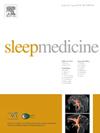阻塞性睡眠呼吸暂停患者血浆IL-22和Claudin-4:一项将粘膜屏障生物标志物与疾病严重程度联系起来的初步观察研究
IF 3.4
2区 医学
Q1 CLINICAL NEUROLOGY
引用次数: 0
摘要
背景:阻塞性睡眠呼吸暂停(OSA)是一种由间歇性缺氧(IH)引起的损伤引起的低度炎症。白细胞介素-22 (IL-22)是一种粘膜靶向细胞因子,可调节紧密连接蛋白Claudin-4 (CLDN4)增强屏障功能,但其在OSA中的作用尚不清楚。方法本初步观察性研究纳入连续接受多导睡眠描记术的患者。采用酶联免疫吸附法测定血浆IL-22和CLDN4水平。采用ih暴露大鼠结肠组织模型进行组织学和免疫组化分析。所有统计分析均使用SPSS 20.0进行。结果OSA患者血浆IL-22与CLDN4表达呈正相关(r = 0.512, p <;0.001)。血浆IL-22和CLDN4水平与呼吸暂停低通气指数呈显著正相关(p <;0.001)、觉醒指数(p = 0.001和p = 0.014)、氧去饱和指数(p <;0.001, p = 0.001), T90 (r = 0.379, p <;0.001和p = 0.002)。它们还与睡眠效率呈显著负相关(0.029;p = 0.004)、REM睡眠阶段(p = 0.037和p = 0.015)和平均血氧饱和度(SpO2) (p = 0.044和p = 0.006)。OSA组血浆IL-22、CLDN4显著升高(p <;0.001),尤其是严重的OSA。血浆IL-22联合CLDN4的诊断价值优于其他指标,诊断OSA的AUC为0.849(0.783-0.915),诊断重度OSA的AUC为0.909(0.856-0.961)。大鼠结肠病理染色证实间歇性缺氧(IH)对肠道的损伤。IH组大鼠肠淋巴结内IL-22和肠上皮内CLDN4均高于正常对照组(NC)。IL-22和CLDN4在大鼠血浆中的表达趋势与组织样品中的表达趋势一致。结论血浆IL-22和CLDN4与OSA严重程度和粘膜屏障改变有关。它们的共同调节与ih驱动的屏障适应的临床前模型一致,支持进一步的机制研究。IL-22 +CLDN4的诊断潜力值得在更大的患者队列中验证。本文章由计算机程序翻译,如有差异,请以英文原文为准。
Plasma IL-22 and Claudin-4 in obstructive sleep apnea: A pilot observational study linking mucosal barrier biomarkers to disease severity
Background
Obstructive sleep apnea (OSA) is characterized as a low-grade inflammatory condition resulting from injury induced by intermittent hypoxia (IH). Interleukin-22 (IL-22), a mucosa-targeting cytokine, regulates tight junction proteins like Claudin-4 (CLDN4) to enhance barrier function, yet its role in OSA remains underexplored.
Methods
This pilot observational study included consecutive patients who underwent polysomnography. Plasma IL-22 and CLDN4 levels were measured using an enzyme-linked immunosorbent assay. Rat models of IH-exposed colon tissues were used for histology and immunohistochemical analysis. All statistical analyses were performed using SPSS 20.0.
Results
The expression of plasma IL-22 and CLDN4 was found to be positively correlated in OSA patients (r = 0.512, p < 0.001). Plasma IL-22 and CLDN4 levels exhibited a significant positive correlation with the apnea–hypopnea index (both p < 0.001), arousal index (p = 0.001 and p = 0.014), oxygen desaturation index (p < 0.001 and p = 0.001), and T90 (r = 0.379, p < 0.001 and p = 0.002). They also exhibited significant negative correlations with sleep efficiency (0.029; p = 0.004), REM sleep phases (p = 0.037 and p = 0.015), and mean oxygen saturation (SpO2) (p = 0.044 and p = 0.006). Plasma IL-22 and CLDN4 were significantly increased in the OSA group (p < 0.001), especially in severe OSA. The diagnostic value of plasma IL-22 combined with CLDN4 was superior to that of other indicators, with an AUC of 0.849 (0.783–0.915) for diagnosing OSA and an AUC of 0.909 (0.856–0.961) for diagnosing severe OSA. Pathological staining of the rat colon confirmed the damage of intermittent hypoxia (IH) to the intestine. The rat IH group had more IL-22 in the intestinal lymph node and more CLDN4 in the intestinal epithelium than the normal control (NC) group. The expression trends of IL-22 and CLDN4 in rat plasma were consistent with those observed in tissue samples.
Conclusion
Plasma IL-22 and CLDN4 were associated with OSA severity and mucosal barrier alterations. Their co-regulation aligns with preclinical models of IH-driven barrier adaptation, supporting further mechanistic investigation. The diagnostic potential of the IL-22 +CLDN4 panel warrants validation in larger patient cohorts.
求助全文
通过发布文献求助,成功后即可免费获取论文全文。
去求助
来源期刊

Sleep medicine
医学-临床神经学
CiteScore
8.40
自引率
6.20%
发文量
1060
审稿时长
49 days
期刊介绍:
Sleep Medicine aims to be a journal no one involved in clinical sleep medicine can do without.
A journal primarily focussing on the human aspects of sleep, integrating the various disciplines that are involved in sleep medicine: neurology, clinical neurophysiology, internal medicine (particularly pulmonology and cardiology), psychology, psychiatry, sleep technology, pediatrics, neurosurgery, otorhinolaryngology, and dentistry.
The journal publishes the following types of articles: Reviews (also intended as a way to bridge the gap between basic sleep research and clinical relevance); Original Research Articles; Full-length articles; Brief communications; Controversies; Case reports; Letters to the Editor; Journal search and commentaries; Book reviews; Meeting announcements; Listing of relevant organisations plus web sites.
 求助内容:
求助内容: 应助结果提醒方式:
应助结果提醒方式:


